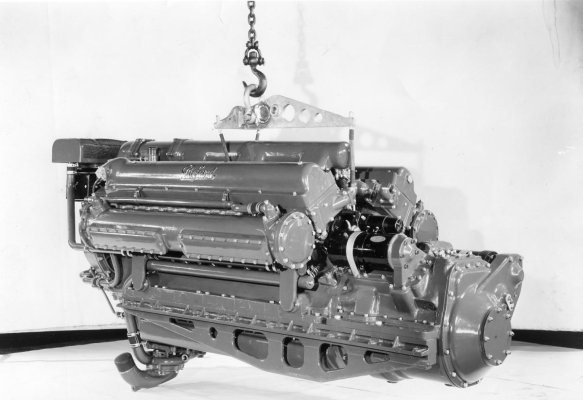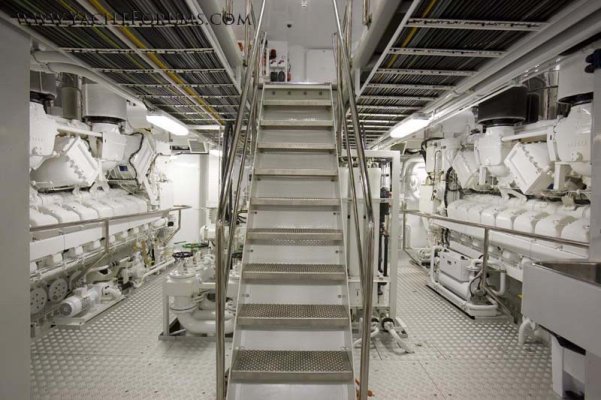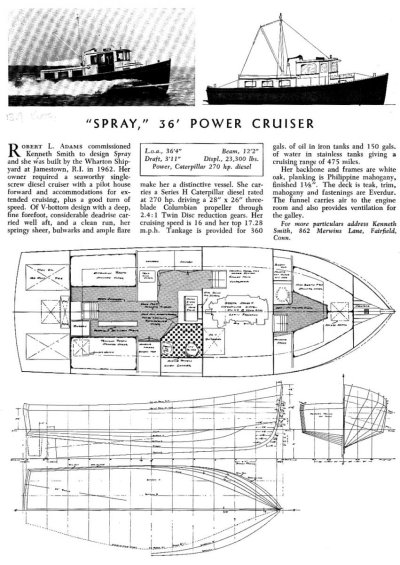Wifey B: Now that's one freaking weird boat. .... It it's not too much trouble can I ask what the heck that is?
It's the Elco 80' PT (Patrol Torpedo) boat that was used by the US Navy in WWII. Hundreds of them were produced by Elco and Higgins. The Higgins boat, while built to perform the same mission, looks somewhat different.
The boat in the Elco company builder's photo is PT117. PTs were not commissioned as individual boats but as squadrons, most of which consisted of 12 boats. They were considered expendable, throw-away weapons, sort of like rifles. Hence the squadron commissioning and no names, just numbers. The crews gave them nicknames, of course.
PT-117 was one of a batch of Elco PTs that included the most famous PT boat of WWII, PT109, the one commanded by John F. Kennedy.
The Elco boats, which arguably were the better of the two, were 80 feet long and were powered by three Packard 4M-2500 V-12 marine engines that ran on aviation fuel. They were NOT P-51 engines or any sort of engine out of an airplane although the 4M-2500 did have an aero engine heritage. Each engine developed 1100 horsepower at the start of the war, although by 1945 Packard had managed to up this to 1500 hp. They carried 3,000 gallons of fuel which was just enough to run them for one mission, which in the Pacific usually started at sunset and went until dawn.
I've done a ton of research about the boats over the last 25 years or so, including interviewing a hundred or so PT vets for the purpose of writing a book I have wanted to write for decades since hearing the story from four PT vets in Hawaii way back when. Other book projects have taken priority, but I've been working on the PT book when I can. I'm on Chapter 9 now. It's not a history book or anything, but the story of a specific mission. I guess you could call it a novel based on a true story.
I first became fascinated with the Elco boats when I read a book in the Honolulu Public Library when I was just a little kid called
They Were Expendable. It's the true story of the PTs in the Philippines at the start of the war, and the mission they undertook to evacuate Gen. Douglas McArthur from Corrigedor. They made a movie of the book in 1945 starring John Wayne and Robert Montgomery.
In the course of my research I have been give permission to explore for hours the inside of the only fully restored Elco PT (the inside is normally off-limits to everyone but PT vets), my wife and I have been invited to ride on the only PT powered by it's original type engines, the Packard 4M-2500, I've heard amazing stories from some amazing guys, I've bought just about every book every published about PTs including the hard-to-find book by Vice Admiral John Bulkeley (the skipper of the PT that evacuated McArthur) called
At Close Quarters, the official Navy history of the PTs in WWII. I also have the manuals the PT crews were issued when they reported to PT school and the operating instructions for the Packard 4M-2500. My real prize is a video copy of a color film made by Elco during the war illustrating the entire construction process of the boats, from laying the first plank to test runs to fire the armament.
Very, very cool boats and I would give almost anything to have one and the funds to run it. It would take a lot of money, though. At the boat's maximum sustained cruise speed at 2000 rpm, fuel consumption was 292 gallons per hour. At top speed (about 40 knots although they only went that fast when they were brand new), fuel consumption was a miserly 474 gallons per hour.
The hulls were double-diagonal mahogany planked with a layer of doped canvas between the two layers of planking for waterproofing. Basically, the hulls were great big Chris Craft runabout hulls. The decks were conventionally planked. The only plywood in the boats (plywood only bends one way) were in some of the deck structures and the the two twin-.50 caliber gun turrets.
At the end of the war, almost all the PTs-- Elcos and Higgins--- were stripped of their armament and anything else of value to the Navy, and then the boats were burned en masse where they floated in the combat theatres. The only survivors were a handful of boats that were completed right at or just after the war's end and were never sent overseas. Some were purchased surplus, re-engined, sometimes shortened, and converted into yachts. Others just ended up in the mud in a Navy base backwater where they rotted away. A very few were kept around, slowly decaying until somebody or some vets organization obtained them and restored them.
So there you go. That's a pretty simplistic descripion of the boat and its history and is probably way more than you ever wanted to know and WAY off-topic but I hope that satisfies your curiosity.






